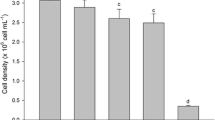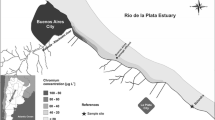Abstract
Toxicity of copper to phytoplankton depends on the physicochemical form of the metal. Organic substances liberated into the culture medium by the phytoplankton species Cricosphaera elongata are able to detoxify and complex copper. The molecular weight range of these organic substances has been determined by ultrafiltration.
Similar content being viewed by others
Literature Cited
Anderson, G.C. and R.P. Zeutschel: Release of dissolved organic matter by marine phytoplankton in coastal and offshore areas of the Northeast Pacific Ocean. Limnol. Oceanogr. 15, 402–407 (1970)
Barelli, M.: Etude des pollutions chimiques au moyen de deux chaînes trophiques marines. Application aux phénomènes de concentration de polluants métalliques, chrome, cuivre, zinc, mercure, plomb, à travers les organismes marins, 130 pp. Thesis, Université de Nice 1975
Batley, G.E. and T.M. Florence: Determinations of the chemical forms of dissolved cadmium, lead and copper in seawater. Mar. Chem. 4, 347–363 (1976)
Bentley-Mowat, J.A. and S.M. Reid: Survival of marine phytoplankton in high concentrations of heavy metals and uptake of copper. J. exp. mar. Biol. Ecol. 26, 249–264 (1977)
Courau, P.: Méthodes d'analyse des métaux lourds (cadmium, mercure, plomb, zinc) dans l'eau de mer et le plancton, 13 pp. Raport no 20 du Centre de Recherches Océanographiques de Villefranche-sur-Mer 1976. (Internal publication, copies available from: Centre de Recherches Océanographiques de Villefranche-sur-Mer, F-06230 Villefranche-sur-Mer, France)
Daumas, R.A.: Variations of particulate proteins and dissolved amino-acids in coastal seawater. Mar. Chem. 4, 225–242 (1976)
Davey, E.W., M.J. Morgan and S.J. Erickson: A biological measurement of copper complexation capacity of seawater. Limnol. Oceanogr. 18, 993–997 (1973)
Dubois, M., K.A. Gillies, J.K. Hamilton, P.A. Rebers and F. Smith: Colorimetric method for determination of sugars and related substances. Analyt. Chem. 28, 350–356 (1956)
Duursma, E.K.: The production of dissolved organic matter in the sea as related to the primary gross production of organic matter. Neth. J. Sea Res. 2, 85–94 (1963)
Lowry, O.H., N.J. Rosebrough, L.A. Farr and R.J. Randall: Protein measurement with the Folin phenol reagent. J. biol. Chem. 193, 265–275 (1951)
Morris, O.P. and G. Russell: Effect of chelation on toxicity of copper. Mar. Pollut. Bull. 4, 159–160 (1973)
Ogura, N.: Molecular weight fractionation of dissolved organic matter in coastal seawater by ultrafiltration. Mar. Biol. 24, 305–312 (1974)
Ramamoorthy, S. and D.J. Kushner: Heavy metal binding sites in river water. Nature, Lond. 256, 399–401 (1975)
Romeo, M.: Contribution à l'étude de la toxicité des métaux lourds vis-à-vis des organismes marins. Transfert du chrome, cuivre, zinc, mercure et plomb le long de deux chaînes trophiques de type néritique et benthique, 118 pp. Thesis, Université de Nice 1975
Steeman Nielsen, E. and H. Bruun Laursen: Effect of CuSO4 on the photosynthetic rate of phytoplankton in four Danish lakes. Oikos 27, 239–242 (1976)
— and L. Kamp-Nielsen: Influence of deleterious concentrations of copper on the growth of Chlorella pyrenoidosa. Physiologia Pl. 23, 828–840 (1970)
— and S. Wium-Andersen: Copper ions as poison in the sea and in freshwater. Mar. Biol. 6, 93–97 (1970)
Stolzberg, R.J. and D. Rosin: Chromatographic measurment of submicromolar strong complexing capacity in phytoplankton media. Analyt. Chem. 49, 226–230 (1977)
Sunda, W. and R.R.L. Guillard: The relationship between cupric ion activity and the toxicity of copper to phytoplankton. J. mar. Res. 34, 511–529 (1976)
Thomas, J.P.: Release of dissolved organic matter from natural populations of marine phytoplankton. Mar. Biol. 11, 311–323 (1971)
Wheeler, J.R.: Fractionation by molecular weight of organic substances in Georgia coastal water. Limnol. Oceanogr. 21, 846–852 (1976)
Williams, P.M.: The association of copper with dissolved organic matter in seawater. Limnol. Oceanogr. 14, 156–158 (1969)
Author information
Authors and Affiliations
Additional information
Communicated by J.M. Pérès, Marseille
Rights and permissions
About this article
Cite this article
Gnassia-Barelli, M., Romeo, M., Laumond, F. et al. Experimental studies on the relationship between natural copper complexes and their toxicity to phytoplankton. Mar. Biol. 47, 15–19 (1978). https://doi.org/10.1007/BF00397014
Accepted:
Issue Date:
DOI: https://doi.org/10.1007/BF00397014




